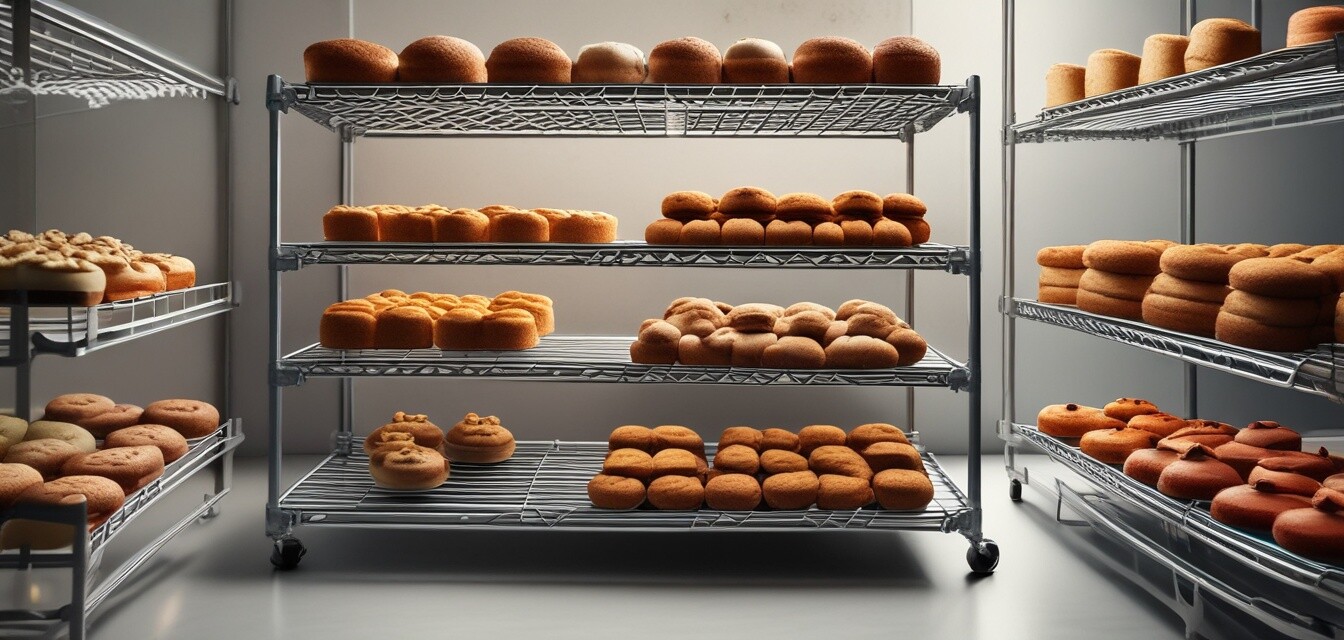
Disclosure: The FTC requires that this article indicate that it was created using AI and is not based on personal experience. It includes affiliate links, which means we may earn a commission if you purchase through these links at no extra cost to you. As Amazon Associates, we earn from qualifying purchases. Product recommendations and endorsements were generated by AI and do not reflect personal opinions or real-world use.
Cooling and storing baked goods for large events
Key Takeaways
- Proper cooling techniques prevent sogginess and preserve texture.
- Storing baked goods in airtight containers ensures freshness.
- Mass preparation strategies save time and reduce last-minute stress.
- Labeling storage containers helps to keep track of different items.
When preparing for large events, the last thing you want to worry about is the quality of your baked goods. Whether it's cakes, cookies, or pastries, proper cooling and storage are critical to maintaining freshness and taste. This article will discuss best practices for cooling and storing baked goods effectively, ensuring that everything tastes as good as it looks!
Why cooling is essential
Cooling baked goods properly not only enhances their flavor but also ensures that their texture remains perfect. Here’s why cooling is crucial:
- Prevents sogginess: Cooling baked items like cakes or brownies on wire racks allows airflow, preventing moisture build up.
- Maintains structure: Cooling helps baked goods maintain their shape. Rapid cooling in a fridge can cause some cakes to contract, leading to cracks.
- Enhances flavor: Cooling allows flavors to settle and develop properly, making your treats tastier.
Best practices for cooling baked goods
- Use wire racks: Transfer hot baked goods to wire racks immediately after coming out of the oven for optimal cooling.
- Aim for room temperature: Allow items to cool in a well-ventilated area at room temperature. This typically takes about 30 minutes to 1 hour.
- Cake considerations: For larger cakes, you may need to let them cool in their pans for 10 – 15 minutes before transferring them to a wire rack.
- Do not stack: Avoid stacking warm baked goods on top of each other to prevent steam buildup, which can lead to sogginess.
Storing baked goods efficiently
Once your baked goods have cooled, storing them in a way that preserves their freshness is the next challenge. Here are some effective storage techniques:
Storage solutions
| Baked Good Type | Storage Method | Optimal Storage Time |
|---|---|---|
| Cakes | Airtight cake domes or plastic wrap | Up to 3 days at room temperature |
| Cookies | Airtight containers with parchment paper | 1 week at room temperature |
| Breads | Paper bags or bread boxes | 3 – 4 days at room temperature |
| Pies | Cover with plastic wrap | 2 – 3 days at room temperature |
| Brownies | Airtight container or aluminum foil | Up to 5 days at room temperature |
Longer storage options
If you need to prepare items well in advance, consider freezing your baked goods. Here are tips for freezing:
- Wrap tightly: Wrap baked goods in plastic wrap, followed by aluminum foil to prevent freezer burn.
- Label items: Use permanent markers or labels to note the baking date and item type.
- Thawing: For best results, allow frozen goods to thaw slowly at room temperature.
Organizing your storage process
To maintain a streamlined process while preparing for large events, organization is key. Consider the following:
Tips for a successful storage and cooling process
- Plan your baking schedule to cool and store different items in batches.
- Use clear containers to visually identify contents quickly.
- Label all containers with the item name and storage date.
- Keep a checklist of baked goods to ensure nothing is forgotten.
- Involve team members to assist with cooling and storage processes.
Proper presentation matters
Once your baked goods are cooled and stored, it’s time to think about presentation. Ensuring your food looks as appealing as it tastes is key for large events.
- Use attractive serving platters: Consider using colorful platters or cake stands to elevate your presentation.
- Garnish effectively: Add small touches, such as fresh mint or berries, to plates to create visual appeal.
- Consider height: Layering different baked goods can create an enticing display that is visually appealing.
Conclusion
Cooling and storing baked goods correctly is vital to maintaining their quality for large events. By following these best practices and tips for cooling, storage, and presentation, you can serve delightful baked goods that impress your guests and enhance their experience. Take advantage of these techniques to ensure your baking efforts pay off and everyone enjoys the delicious treats you've prepared.
Read more
If you are interested in learning more about cooking for groups, be sure to check out our other resources: